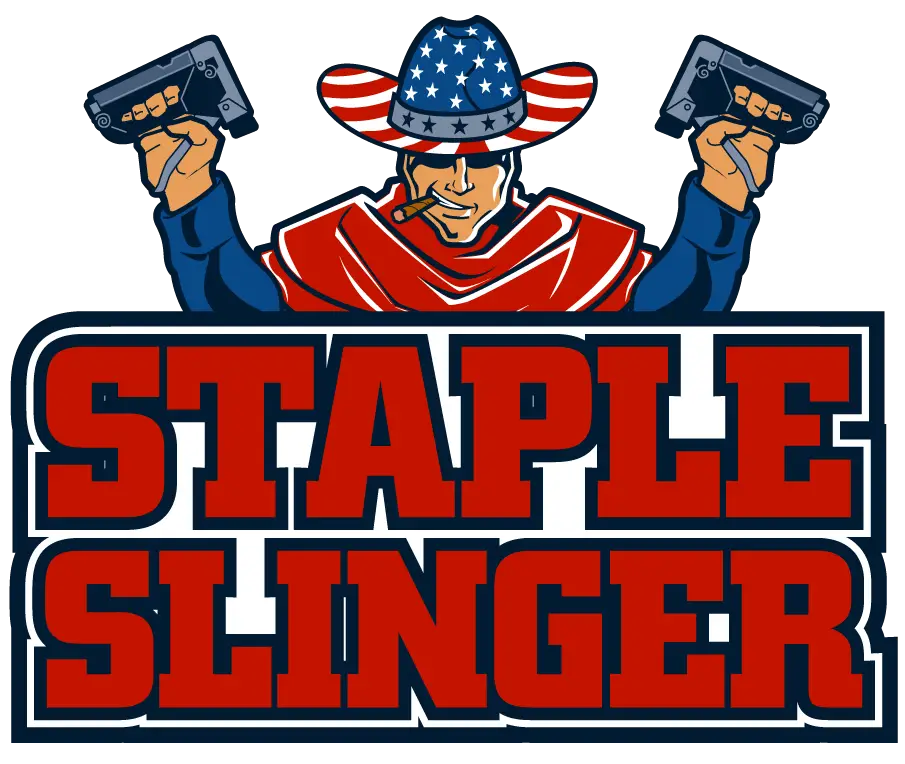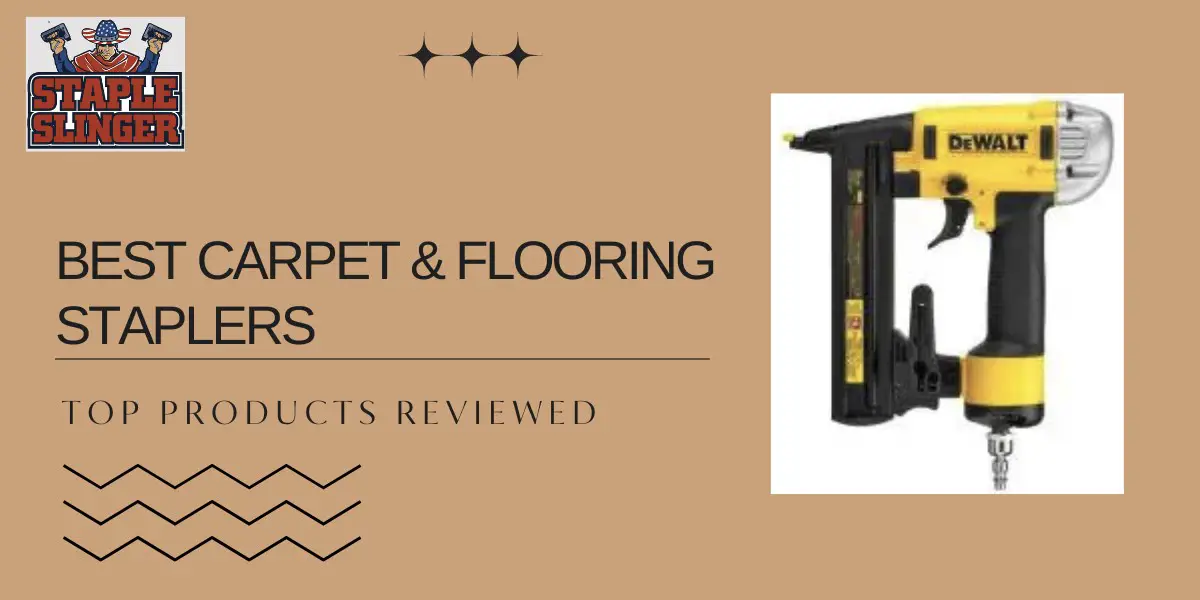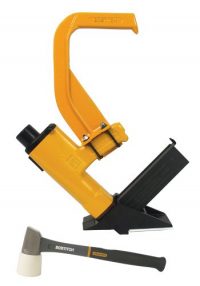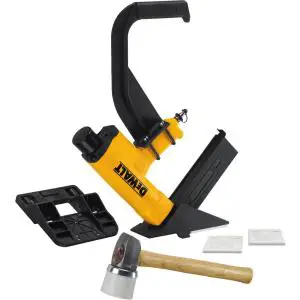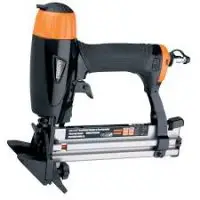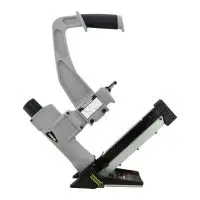Best Carpet & Flooring Staplers
Carpet and flooring staplers are a high quality tool that can help you install some amazing floors in your home.
The modern stapler in this category can work with laminate flooring, hardwood flooring, laying carpet, and even install upholstery or assemble wood products if need be.
Whether you’ve got a DIY remodeling project that needs to get done or this is what you do to earn a living, the best carpet and flooring staplers will save you time, save you money, and help you to produce incredible results.
Are You In A Hurry? Our Test Winner After 35 + Hours Of Research:
Click Image For More Info
Bostitch MIIIFS Pneumatic Stapler
Our Rating
Click here to check the latest price and checkout the reviews
Best Carpet & Flooring Staplers Chart
When you look up the best carpet and flooring staplers online, you’ll find a number of different models from brands like Bostitch, Senco, and Powernail.
Many of the brands create products that look pretty much the same.
How can you tell which staplers are the best?
The chart below is a great place to get started.
Our Top 5 Best Carpet & Flooring Staplers:
1. Bostitch MIIIFS Pneumatic Carpet Stapler (Best Overall Stapler for Carpets)
2. DEWALT DWFP1838 18 Gauge Finish Carpet Stapler
3. Reconditioned Bostitch Pneumatic Carpet Stapler
4. Surebonder 9600A Heavy Duty Carpet Stapler Gun w/ Case
5. Freeman PFBC940 Carpet Staple Gun
|
Rank |
Picture |
Name |
Shop |
|---|---|---|---|
|
No. 1 |
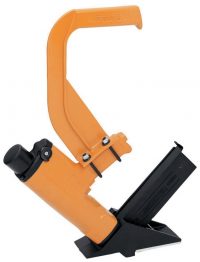 |
||
|
No. 2 |
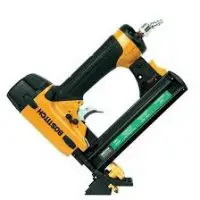 |
||
|
No. 3 |
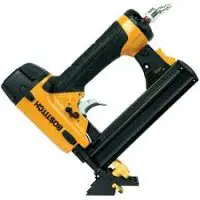 |
||
|
No. 4 |
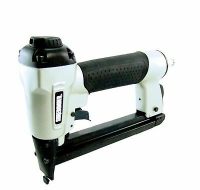 |
||
|
No. 5 |
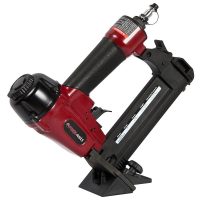 |
|
Rank |
Picture |
Name |
Shop |
|---|---|---|---|
|
No. 1 |
 |
||
|
No. 2 |
 |
||
|
No. 3 |
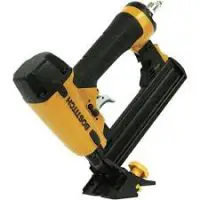 |
||
|
No. 4 |
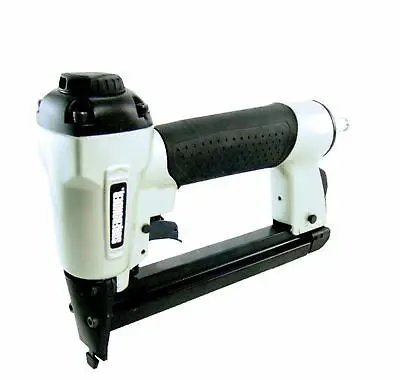 |
||
|
No. 5 |
 |
||
|
No. 6 |
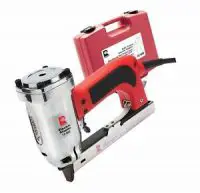 |
||
|
No. 7 |
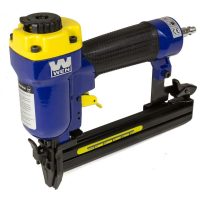 |
||
|
No. 8 |
 |
||
|
No. 9 |
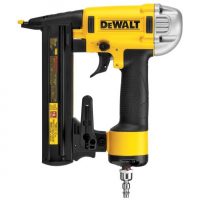 |
||
|
No. 10 |
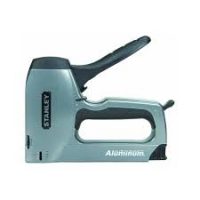 |
What Do Our Reviews Have To Say?
Click Image For More Info
#1. Our Overall Top Pick
Bostitch MIIIFS Pneumatic Stapler
Our Rating
The Bostitch pneumatic stapler is one of the most powerful staplers that you can use. It has a high-speed operation that provides over 20 pounds of driving power when stapling.
This is very impressive for a staple gun, and you would only need a little effort to use this stapler. It also has a handle that makes gripping and using it easy.
We found that the gun weighed just a little over 11 pounds, but can be used to staple several inches of hardwood or carpet flooring. It makes use of a 92-staple magazine, so there’s little downtime when stapling with the device.
What’s admirable about this device is that the base plates of the Bostitch 1-1/2-inch to 2-inch pneumatic stapler are interchangeable.
The plates make the gun sit easily on the flooring, and drives the staples to the desired depth.
The Bostitch 1-1/2-inch to 2-inch pneumatic stapler is a versatile stapler. It’s ideal for both DIYers and professionals.
When it’s used, the stapler’s floorboard adaptor doesn’t scratch flooring which results in a damage-free floor finish.
Before you leave, why not check out our best Saddle Stapler guide – and see what our top picks are.
Things We Like About This Product:
- It has an immense driving power
- It staples quickly
- It doesn’t scratch flooring
Things We Don’t Like About This Product:
- It’s heavy
Click here to check the latest price and checkout the reviews
Video Transcript
and let’s look at the stanley Bostitch range of flowing tools now to start with we’re going to look at the t6 and taka the t6 hand tacker uses the STC our staple as you can see by the crime of the staple its arched this this it gives a staple more holding power as a staple was driven in legs spear Mac giving a fish hook perfect gives it extra holding power it still would be used for stapling down carpet underlay before you fit your final carpet on top toilet stuff comes in a nice little plastic blow molded case three boxes of fixings in various different sizes 8 10 and 12 move it along to the 1855 Brann Dailor once you’ve fitted your laminate floor or your wood floor very often you’ve got to go around it and fix the beading to cover the gap it still will drive 18 gauge brad from 12 mil at 255 mil what you can do is place the tool on the material and just pin the beading to the script board okay these are our hardwood flooring tools stapler nailer and nailer this is the m2 Bligh FS this is the floor stapler it’s for fire a staple to a maximum 50 mil just over here it’s brother this is um triple I FM this will fire a floor cleat up to a maximum of 50 mil handy additional parts of this tool is the floor kit you can attach the full kit to the bottom of the floor nailer and this allows you to speed the process up without scratching the floor moving over to the mfn2 one this is our new flooring nailer manual flooring nailer there’s no need for a compressor with this tool it’s a completely independent it still would drive 50 ml cleats and 13 mil cleats firstly we replace the tool on your wooden floor and as you can see by the angle of the tool it fits perfectly into the tongue of the floor you would then pick up your graphite mallet simply strike the tool drive in the fastener through the tongue at a 45 degree angle into the beam let’s talk about a few features of the tool the tool itself has a graphite hammer very light anti-vibration the tool also has incorporated in the body rubber feet so if the tool was to fall over you wouldn’t scratch or damage the surface the tool also has a unique ratchet system currently the present it’s on ratchet this would allow you to drive the faster bit-by-bit into the timber that’s not quick enough for you you can simply remove the pin turn the magic around they spin back in allowing you to drive the fastener one single shot the fluorine then also comes with the selection of shims as you can see you simply remove the screws remove the shim fit the additional shim and that will allow you to do different size floor 12 mil 50 mil and 20 mil it also comes with a 7 year limited warranty and comes in a tough plastic blue multi case using this tool is a quick and easy way to do a professional job now let’s see in action thanks for watching guys see you next time
Click Image For More Info
DEWALT DWFP1838 18 Gauge Finish Stapler
Our Rating
This staple gun will help you install virtually any floor you can imagine in your home.
The no-mar installation point is overmolded so that there is an increased protection for your flooring materials.
It’s gentle enough as a staple gun to let you install padding, yet firm enough to work with most hardwood options.
Because you might need to work at some unusual angles from time to time, you can even move the exhaust channel 360 degrees for convenience.
Our Guide to the best Heavy Duty Staple Removers features more products that every tool box needs.
Click here to check the latest price and checkout the reviews
Video Transcript
The Dewalt DPN 1850PP-XJ is a pneumatic nailer that can fire in between 15 millimeters and 55 millimeter long nails. This machine comes with a quick-release coupling it’s very lightweight and easy to use. It has two modes of operation it has the sequential fire which is set there which will fire in a single nail at a time or if you press that button you can actually turn that and you can then put it onto bump mode. When it’s on bump mode you can fire in nails very quickly indeed. This machine does come with a hook so you can hook it on the bench or you can hang it up when you’re not using it. It also has a useful feature in that it has a built in pencil sharpener. So you can simply sharpen your pencil in that part. To load the machine it’s very easy, simply press on that bottom open up the magazine, place the nails in there the correct way around with the head at the top, and then close the magazine. That’s it, that’s how easy it is to load the machine. If you get a jammed nail it’s very easy to remove it simply press that button, pop the nails out and then at the front there we have tool free jam clearing. Simply pull that forwards and then that enables you to open up that part, you can then remove the jammed nail before pushing that back again. So it is very quick and very easy to remove any jammed nails from this machine. So the machine is now in the sequential mode which means that we can fire a single nail in at a time or we can switch over to bump fire mode and then we can fire in the nails every time the nozzle bounces down. You can easily adjust the depth to which the nails are sunk using that dial that you can simply turn with your finger. On the magazine there, there is a window where you can actually see the nails. Once you get down to your last few nails that will actually turn yellow as there is an indicator in there that then tells you that you need some more nails to the machine. The tip on the end of this machine is designed not to mark the work piece even if you’re fixing something that is very soft. The tip requires minimal pressure before you can activate the machine and fire in the nail. This will be ideal for cabinet making etc because of the size of the nose piece meaning it can get into some really tight places and because you need so little pressure to activate the machine there’s not chance at all of you damaging the workpiece. This nailer also comes with a quality Dewalt carry case which has quality metal clasps.
Click Image For More Info
Reconditioned Bostitch Pneumatic
Our Rating
Sometimes you can find a great deal online for a carpet and floor stapler.
That’s the case with this reconditioned pneumatic floor staple gun. It’s been reconditioned at the factory and has the same warranties as a brand new model.
It holds up to 92 staples at a time, uses 15.5 gauge staples, and works best with either solid or engineered wood floors. Is there a chance you might be purchasing a lemon?
That’s always possible… but our testing period was very successful and we would readily include this tool in our toolboxes for home use.
Check out our review of the best box staplers for our top picks.
Click here to check the latest price and checkout the reviews
Click Image For More Info
Surebonder 9600A Heavy Duty Stapler Gun w/ Case
Our Rating
The Surbonder 9600A stapler is my favorite for heavy-duty works. I like that this stapler is convenient and easy to hold down different floorings.
This pneumatic stapler can be used with different sizes of staples and is also suitable for quickly fixing carpets and floors at home.
The Surbonder 9600A stapler has a quick-release lockout in case the stapler jams.
The 9600A model has a modern handle design. I like that it can hold up to 100 staples at a time, which reduces the time to refill them.
The device works under a safety mechanism that prevents accidents and injuries while using it. I like that the stapler is well balanced and can be used continuously throughout the day.
The exhaust on this stapler is adjustable so that you can direct debris away from your body and work-area.
I also like that it fires using a bumping mechanism, as it doesn’t have a power button. The speed of this stapler is also an impressive feature. It staples very fast for its size but doesn’t produce as much power as we would’ve wanted.
The Surbonder 9600A stapler comes with a quick connector, two wrenches, and a conveying case.
We have also reviewed the best Manual Staple Gun, so check them out as well.
Things We Like About This Product:
- It staples quickly
- It’s compact and lightweight
- It holds a decent number of staples at a time
Things We Don’t Like About This Product:
- It delivers less power when stapling
Click here to check the latest price and checkout the reviews
Video Transcript
so today we’re gonna have a quick look at the sure Bhandar 9600 B now I bought this stapler because I wanted to do some upholstery work recovering some seats on jet skis four-wheelers things like that and I tried using a hand stapler and just wasn’t cutting it that’s why I got this little guy now this is incredibly inexpensive air stapler I think I paid about 30 bucks for mine and it seems to be very well built let’s have a close-up look at this see some of the features of it and see the one modification that I couldn’t live without the instruction manual the stapler itself right here a little bottle of lubricant and it even comes with a tool for servicing it let’s have a look at this gun and see some of the great features it has now mine came with a fitting pre-installed this is 80/50 type stapler so it shoots your regular arrow style staples has button for releasing here you load your staples in with the points facing up like this so facing the way that you’re gonna be shooting them in now this has a safety so see that little guy right there he pushed in over it’s great to fire so that’s the one modification that I couldn’t live without on this stapler getting rid of the safety because I’m using it for upholstery I need to be able to get into a fairly tight spot and not have to worry about that safety hitting things or not hitting things and me pulling the trigger trying to get it to fire when it absolutely will not so let’s show you how to do that you probably could just zip tie this up or do something like that but I really wanted the whole assembly just gone out of the way so a little service tool here we’re going to take these front four screws out and then take this nose apart so that we can get this out so we’ll go ahead and pop that off watch very carefully because they have this little spacer guy on there and you need that to not get lost sometimes they like to stick in this now this is gonna come apart in the following sequence we have a little plastic piece on the front then there’s a spring right here so we want to get that spring out of the way right now so it doesn’t go flying across the room and poke somebody in the eye or something so then there’s a little plate right here behind the safety mechanism has a groove in it we’ll talk about that later and then one little piece right behind the driving part there now as for getting this safety mechanism out we’re gonna have to swing this over to the side a little bit and then pull it down out so that’s that now at this point we can put this all back together because our next thing is in the actual trigger mechanism so this little piece goes behind that little piece then this one goes with the grooved side to see on one side is flat one side is grooved grooved side comes in then our plastic piece then we put our screws back in now you do not need to get these ridiculously tight just decently snug is sufficient okay so now our trigger assembly has little pin that goes through here it has an o-ring on it so what we want to do is buy that little o-ring off let’s see if we can get somewhere where you can see this helps you got nails go that little o-ring comes off we’re gonna set that aside so we don’t lose it then we’re gonna push this pin through and as we do that I can flip it over so we can see this side let’s see if we can zoom in just a little bit okay so as we pull this pin out so this pin is out we’re gonna pull the trigger assembly down and note there’s another spring so you can just snag that little guy there that’s a trigger return spring and then we can work on this now this one as you can see has already been modified this is not how it comes from the factory what I did was took a number ten by three quarter zip screw with a hex head and drove it up through the bottom of this so this little flapper is what depresses this which is what fires the gun so you need to make see you need to make the space in between the bottom of the trigger and the top of this little flapper guy here equal to what it would be if it was being pushed up by this now conveniently the head of that number ten by three quarter zip screw is exactly the right size for that so I just drove it up through from the bottom snapped off the front part drove it up through and then ground the top side flat with the Dremel so once you’ve done that just reassemble in the reverse order to put your spring in and put your trigger in push your pin through your trigger assembly and then put your little over in back on there you go keep in mind once you have done this modification of the staple gun it has no safety pulling the trigger will fire staples directly at the end with nothing in front of it so that could be dangerous it will also fire if you were to be dragging it around and it bumped against your leg or something it could fire and go off so if you decide to do this be extra careful when you’re working with a staple gun because it makes it a lot easier to get hurt or potentially hurt somebody else even though these staples won’t necessarily fire far still be careful so that’s all there is for today thanks for watching
Click Image For More Info
Roberts 10-600 120v 15 Amp Pro Electric Stapler
Our Rating
This staple gun is a beast for your DIY residential projects. Need to install a new carpet?
You’ll be done in no time at all with this tool. Hardwood floors can be installed quickly and without cracking.
You can even take it outside to start putting together that deck you’ve always wanted. There’s enough power to get every job done, but it isn’t over-powered so that you wind up breaking stuff along the way.
At this price point, you won’t find a better stapler to take care of every flooring need.
Find more great products like this by checking out our guide to the best Long Arm Staplers.
Click here to check the latest price and checkout the reviews
Click Image For More Info
Dewalt DWFP 12569
Our Rating
The Dewalt DWFP 12569 stands out among other staplers in the market. It’s a reliable, versatile, and compact stapler that you can use to hold all types of flooring firmly.
The device can work with two kinds of staples, so you won’t be restricted if you choose this model.
The plates of this stapler are excellent, and they allow you to adjust the device to any size or shape of flooring.
The Dewalt DWFP 12569 has a larger rubber handle like many models of Dewalt staplers. Something worth admiring is even though the handle is large, it still gives a comfortable grip.
The stapler has more power than you think it does when you look at it. You can complete flooring and flooring projects quickly with this stapler, and it never misfires.
Its low CFM is quite a disappointment. However, it comes with a mallet that you can use to drive home a few tough staples. The pneumatic gun stapler is versatile and has a magazine that can fasten up to 100 staples.
Our handy guide to the best Heavy-Duty Stapler features more great products like this.
Things We Like About This Product:
- It’s ergonomically designed
- It’s comfortable and easy to use
- It comes with a 2-in-1 magazine
- It has interchangeable base plates
- It has a rubber handle
Things We Don’t Like About This Product:
- It doesn’t have a case
- It doesn’t have a lockout feature for dry fire
- It is heavy
Click here to check the latest price and checkout the reviews
Click Image For More Info
Freeman PFBC940
Our Rating
An awesome budget stapler in the market is the Freeman PFBC940. This Freeman model is one of the smallest we’ve ever seen. Its standout feature is that it doesn’t need oil to work. It’s versatile and can be used both as a floor stapler or nailer.
The Freeman PFBC940 delivers over 70 to 115 psi of power when stapling or nailing.
The first thing that caught our attention in this stapler is it’s amazingly lightweight. You would find its weight very helpful when using it continuously. Another impressive feature of this stapler is that it’s adjustable.
It provides a complete cycle exhaust system, so there’s no concern of debris entering the device or the floor area.
This device works like a skilled professional. You can use it to drive 3/8-inch floorings severally, and it won’t misfire. As long as the loader is clean, the Freeman PFBC940 shouldn’t jam. In rare occasions when it does jam, the quick release system allows you to reach in and remove staples easily.
It would’ve been more convenient to use if the Freeman PFBC940 had a safety trigger.
Make sure you also check out our guide to the best Heavy-Duty Staple Gun.
Things We Like About This Product:
- It’s a versatile and lightweight device.
- It’s made from quality anodized aluminum
- It rarely jams
Things We Don’t Like About This Product:
- It doesn’t have a safety trigger
- Changing the device from a nailer to a stapler takes time.
Click here to check the latest price and checkout the reviews
Click Image For More Info
NuMax SFL618
Our Rating
The NuMax SFL618 is a high-performance budget stapler. It provides interchangeable base plates, just like many other staplers with a similar price.
This device is a 2-in-1 tool that can be used both for stapling or nailing floors and carpets. It delivers staples accurately and precisely to the desired depth. Homeowners and professionals can make use of this stapler in their heavy-duty projects.
The stapler provides two plate options when in use; the ¾-inch plate and the 1/2-inch plate. We like that this stapler can be used to hold down many types of flooring.
The nailer needs to be improved though, as it’s not suitable for nailing thick flooring. Nevertheless, the magazine can hold up to 120 staples and 100 nails at a time, reducing the time to reload.
The downside to this stapler is that it can jam every now and then, so you‘d need to oil it frequently. It’s die-cast aluminum body ensures that the gun lasts for a long time.
The NuMax SFL618 comes with a set of wrenches, a wooden mallet, and oil. It’s perfect for standard hardwood as well as tongue and grooving flooring projects.
Be sure to check out our list of the best Staple Gun for more great items like this.
Things We Like About This Product:
- It isn’t expensive
- It can be used both as a stapler and a nailer
- It is lightweight
Things We Don’t Like About This Product:
- It is not suitable for nailing thick flooring
- It needs to be oiled regularly
Click here to check the latest price and checkout the reviews
Click Image For More Info
WEN 61710 Narrow Crown Stapler
Our Rating
The WEN 61710 Narrow Crown is a compact and ergonomically-designed stapler. The body of this stapler is made from cast iron, which makes it durable.
You can easily use this stapler to produce between 60 to 100 PSI of power when stapling. We’re impressed with the 100-staple capacity of this device.
Even though the stapler jams often, the most impressive feature is the jam-release system of the Narrow crown stapler.
You could use the stapler to deliver ¼, 3/8 and 1-inch staples into platforms easily. However, it takes a few minutes to get used to the loading mechanism.
The stapler has a well-designed handle that makes it easy to grip and hold for an extended period.
The WEN 61710 Narrow Crown Stapler comes with a contact tip operation, a nailer, a quarter-inch air fitting and a case.
The nose of the device is narrow so you can precisely and accurately deliver staples. The WEN 6171 is a pneumatic-powered stapler and very affordable.
Things We Like About This Product:
- It has a case, which makes it portable
- It’s lightweight
Things We Don’t Like About This Product:
- It takes a while to familiarise with the way it works
Click here to check the latest price and checkout the reviews
Carpet and Flooring Stapler Buyers Guide
Choosing a stapler is an important task, and it is necessary to understand the difference between different kinds of staplers before you make your decision.
Here we will brief you on the kinds of staplers available and other information so that you can make an informed decision.
Types of Staplers
There are three types of staplers you can use when fastening carpets or floors; manual, electric, and pneumatic. Even though manual staplers are the most economical, they aren’t recommended for flooring projects.
Manual stapling guns require a lot of physical power to use.
Pneumatic staplers are fuelled by air and drive staples quickly into workpieces. Generally, pneumatic guns have higher stapling performance than most electric guns. The speed of stapling is also faster in pneumatic guns than electric staplers.
The maintenance cost of this type of staplers is low, which contributes to its durability.
However, these guns are much heavier than electric guns because they use compressed air to operate.
The Basics of Carpet and Flooring Staplers
Electric guns, on the other hand, use electricity as their fuel and are very compact. They don’t require oil for smooth operations, which is an advantage they have over pneumatic staplers.
They are preferable when working with light materials because they don’t staple using sheer force. Safety risks are fewer when using electric guns than their pneumatic counterparts.
The operating cost of these staplers is higher than in pneumatic guns because they use electricity.
They also breakdown far more often than pneumatic guns.
When installing a new floor, you’ve got two basic options: cleats or staples. Cleats are often used for hardwood floors because the natural product expands and contracts naturally.
Staples, with their two prong entry, create a firm installation point initially, but can cause cracking with the natural movement of the floor over time that cleats do not cause. Long-term durability goes to cleats instead of staples for a hardwood floor.
Cost is also an important consideration. If you’re trying to improve the look of a room on the cheap, then you can’t go wrong with staples. This is especially true if you’re using instant wood flooring products. Just install the flooring, add a couple of staples here and there, and then finish off the floor with ease. Cleats are much more expensive.
Not all floors are hardwood floors.
Carpeting is also routinely installed in homes and businesses and staples have an advantage here as well. Because there isn’t as much risk of damaging the carpet when too much pressure is applied to the stapler, you can end up with a brand new floor installed in just a few hours with the use of this tool.
How To Find the Best Carpet and Flooring Staplers
You’ve decided on which type of floor you’re going to install. You know that you want a carpet and flooring stapler to help you get the job done. Now you’re ready to begin the shopping process.
How do you find the best carpet and flooring stapler when there are so many from which to choose?
Don’t rely on manufacturer’s descriptions or biased websites that want you to purchase the most expensive tool out there. Look for reviews on sites like Stapler Slinger that are based on real experiences.
I’m a former general contractor reviewing these tools, so let my experiences help you decide which stapler is going to help you out the most.
There’s no pressure here to purchase a certain brand or product.
You’ll also want to think about the gauge that your flooring may require. Carpet and flooring staplers offer gauges from 16-22 in most circumstances.
Some only offer one option, while others allow you to adjust the tool to use multiple gauges. If you need flexibility or think you might have multiple project uses for your new stapler, then look for a tool that is adaptable.
You get information. You make the decision. That’s the key to finding the best stapler in this category. Without real data, you could wind up ruining your brand new floor and that’s a costly mistake indeed.
The Advantages of a Carpet and Floor Stapler
There are various ways to install carpeting or hardwood flooring in a home or business today. You could use glue. You could add tacks along the edges of the flooring.
You can even grout in some floors today if you want. The only problem is that many of these methods are rigid and your floor is not. It is a living, breathing component of your home.
Moisture, temperature, and even how a floor is used causes it to expand and contract over time.
This is even true for carpeted floors thanks to the wood supports underneath it in the subflooring. As this occurs, some installation options quickly degrade and cause the flooring to become loose or the carpets to crinkle up.
You don’t need that headache. Although carpet and flooring staplers can sometimes be difficult to use when attaching tongues that are less than 0.75 inches thick and a staple can cause creaking as the installation point begins to lightly loosen over time, the results are much more consistent.
As long as you’re careful during the installation process to keep the flooring undamaged, you will come out of your project with incredible results when you own the best carpet and floor stapler around.
Easy Application
Tacks, glues, and nails can be used to hold carpets and floors firmly. These methods, however, are rigid and not convenient for temporary projects.
Lasts Longer
Floors contract and expand over time due to different exposure to moisture and temperatures. This is also true for carpets due to the wooden support that needs to be placed under them.
Many installation options like nails and glues degrade and then reduce the grip that they have on floors. You don’t need to go through the stress of changing those fasteners when using staples.
Offers Versatility
Staplers are versatile and easy to use. There are different types and brands to select, and they are generally affordable. Most staplers require little or no effort in stapling floorings.
They deliver the staples to the right depth so that your flooring can be firmly held down.
Most staplers are carefully designed to prevent scratching the surface of the flooring even when they are moved over the floor or carpet. As long as these hand-held guns are rightly used, you should get incredible results.
How to Find the Carpet and Floor Stapler that Suits Your Needs?
After deciding on the type of carpet you want in your home, the next step is to determine the type of stapler you want to use in installing it. There are many manufacturers to pick from, but how do you find a stapler that suits your needs?
Select Your Category
Firstly, decide on the stapler-capacity that will match your requirements. There are three capacity categories of staplers; general-purpose, heavy-duty and light. Look at the type of work you want to do with the stapler and decide which category it falls into and pick staplers that meet your need.
Decide on Your Gauge
Think about the gauge that your floor needs. Floor and carpet staplers provide huge gauges. Many of these guns offer more than one option. If you need a flexible-gauged stapler, then go for an adaptable tool. If not, stick to the gauge that suits your floor or carpet.
What About the Prices of Carpet and Floor Staplers?
This is not a tool that you’ll want to get on the cheap unless you’ve got access to a refurbished product that comes with a manufacturer’s warranty and/or guarantee.
You’re going to get what you pay for and cheap carpet and floor staplers are going to give you low quality results that are unsatisfying.
There are more expensive staplers in this category, but they tend to be more for commercial needs that a general contractor might have rather than a DIY homeowner.
If you can afford these premium products, however, the investment is worthwhile because you typically receive a longer and more comprehensive warranty.
The 6 Best Carpet and Flooring Stapler Brands
Here’s a little about are our top favorite stapler manufacturers.
Bostitch
This American company specializes in making all kinds of fasteners. The brand has been in the stapler-making game for over a hundred years. Many staplers made in this company use a cohered strip designed staples.
Dewalt
Dewalt is another American brand that makes hand and power tools like nailers and fasteners for industries. It began operations in 1923, and most of its hand-held tools have a black and yellow design.
Freeman
This brand just began producing power tools but has made an instant impact on the market. All the tools that are made by Freeman have a 7-year warranty period.
NuMax
Numax makes simple power tools at affordable prices. Their staplers come with a mallet and can be used as a nailer. There’s a 1-year warranty for all the power tools they make.
WEN
WEN is a brand that produces different power tools, saws, and other machine parts. The most popular product produced by this brand is its saws.
Surbonder
Surbonder produces glue sticks, rivet tools, staple guns, and nailers from high-quality materials. They operate in the USA but distribute their products all around the world. Most of their hand-held staplers come with cases.
FAQ’s
Here are some common questions that may arise during your search for the perfect carpet and flooring stapler:
How do you staple a carpet?
Before stapling your carpet or floor, wipe the surface and remove any dust and dirt from it. Afterward, place the staple gun in position. Ensure that it balances on the carpet or floor’s surface. Then, load the staples into the gun. Your stapler may have a button, trigger, or may use a bump-trigger mechanism. In either case, press on the handle and make sure the nose of the stapler touches the flooring when stapling.
Do carpets need to be glued before being stapled?
No, you don’t need to use glue on your carpet before stapling it. The staples and the power delivered by the stapler are enough to hold it down firmly.
How do you unlock the safety feature?
The safety lock of a stapler remains engaged until it’s turned off. To turn off the safety lock on the stapler, press the button or switch used to lock it. A stapler can’t be used if this feature is switched on.
How do I unjam my stapler?
If you have staples in your stapler but can’t use the device, then it’s probably jammed. Each stapler has a different process of unjamming. However, all of them require you to do so manually.
Open the compartment at the back of the stapler and use a reaching tool to grab the staple that is stuck in it. You should hear a clicking sound when this staple is removed.
How do I oil my pneumatic stapler?
Oiling your stapler is the first thing you should do when you get one. Put one drop of oil in the hooked end of the gun before connecting the air hose to the stapler.
Do you need a stapler that has a safety lock?
Not many carpet and floor staplers come with a safety lock. You should always prioritize your safety by getting one with this feature. A safety lock is essential as staples can accidentally get stuck in your clothing or hand.
The safety lock works by switching off the stapler when it’s not in use.
However, you still need to take precautions when stapling floors and carpets.
Wear goggles and protective clothing, and be cautious of people around you when using a stapler.
Final Words
The Dewalt DWFP 12569 is our top choice. It’s not the lightest you can get, but you’d be impressed with the balance and control this stapler brings to the table. It’s optimized to be used on most floors and carpets.
We find its long handle very comfortable to hold for long periods of time. The best part is that it hardly jams so that you can use it easily.
However, if you’re on a tight budget, then we’d suggest you take a look at the Freeman PFBC940 stapler. It’s a very portable choice that professionals and homeowners can use to get a stapling project done quickly. This stapler makes renovation chores easy and tidy.
Getting the right stapler that suits your need is essential. Always make a list of the best things you want in a stapler, and let that be your compass when you start shopping for it.
Read also The best staple gun for wood
What Are Others Saying
How to Install Carpet on Stairs – how hard is it?
Video Transcript
hey Adam I’m wondering if it’s worth it to recarpet stairs myself or if it’s better off in the long run just to pay somebody to do it I’m kind of handy but I’ve never done carpet before what do you think actually I’ve never done stairs either I’ve done smaller rooms things that you don’t really need many tools for I don’t have a carpet kicker I don’t have a stretcher but I got away with it and it worked for the small rooms with stairs I’ve never done it but recently I’ve had some carpet replaced in a couple rooms and the carpet under the bed and the couches look brand new so what we’re going to do is I cut that out cut out the pad on the carpet and I’m gonna see if we can use that to recarpet these stairs I have no idea how long this will take but I got all day let’s find out let’s find out if it’s worth it all right so to remove the carpet I’ve done a couple steps here there’s tack strips all around and there’s also staples so it’s a lot of yanking and pulling you probably want to wear gloves because when you grab one of these staples it’s going to get you one trick for removing these at least the staples around the bottom edge down here let me show you okay I’m having a hard time there so let me lay the carpet down just put my weight on this leg you can hear that tearing that’s the staples coming out see that all right so that’s loose here notice that instead of using like this part of your foot use the heel there we go three o’clock exactly carpets ripped out now we got to tear up the carpet pad and then I’ll go through and rip out all these staples so all the old stuffs worn out and it’s all cleaned up vacuum ready to go I’m going to staple down the new pad with one of these this brand is a duo fest any products that I use if you have questions about it check the video description for links to those and maybe some more answers to your questions here’s the Staples and these are just what I already had these are 5/16 inch so with this one you lift this up pull this out pull this out slip some staples in there and this works just like a hammer you just slam it down and I use this a lot actually a lot more than I thought I would but if you’re wondering if it’s worth buying I think so you know and yeah again the brand I’m using is dual fast I’m not recommending that brand but I’m not not recommending it either there it’s served me well I don’t have any problems with it alright that was a little sloppy but I’m sure I’ll get better all right I’ve done three steps now a pad and what I learned cut a nice clean edge before you’re going to lay it down so I know this edge is nice and clean and straight I can line it up on here done and ready to put in the carpet so all the steps have pad we’re all done I cleaned everything up I got the compressor out and ready I’m going to be using these these are half-inch staples with a quarter inch crown put it in the gun like that that’s about it okay so if you haven’t used one of these before you push down and pull the trigger and it throws one in so to cut the carpet just use a straight edge and a utility knife push pretty hard and it cuts really easy just do it along the back here’s six-and-a-half feet of carpet let’s see how far we can get now we’re going to use this to force it in here so let me push it down I’m not going to go down this way I want to get it this way and let’s see how this works I really didn’t know what to expect so that’s it one down let’s move this next one here bending it in by hand tuck it under well I gotta say so far I think it’s looking pretty pro I mean I don’t think anybody would think that you know this was done by somebody who never did it before it’s looking pretty good to me all right a little note when you’re cutting the width of the carpet you want to measure wall to wall and so wall the wall is 42 and a half inches so I’m cutting the carpet exactly 42 and a half inches but also go up and check to make sure that it doesn’t get wider or more narrow the higher you go if it gets narrow you can cut some off but it gets if it gets really wide you’re gonna have a gap so just make sure that you know the distance the width so you can cut it the right size all right there’s just a few more steps left and then I’m done I noticed that once I nailed this down underneath here if I take this you tell them out of breath I’ve been building trying to get this done quick if you take this take out the slack here all right and then Ram it in like that by hand all along so what you’re doing you can see the bulge here I don’t know if you can but ramming it in onto the tack strip that helps take out the slack not on the same thing you know just chisel listen okay so what pulls like carpet in that’s it gonna keep going we are done what is it 9:20 alright well I finished late last night and I cleaned it up today and do I think it was worth doing myself or should I pay somebody else well I didn’t mind it it was exhausting it was pretty tiring so the guys at lay carpet and they’re earning their money it’s it’s worth it to pay him if if you can get a good deal on it but other than that I’d say yeah go for yourself especially if you already have a staple gun and a compressor and there’s not really much of a tool investment I’ll leave links it in the video description below for all the tools I used in any updates on this and anyway if you try it yourself let me know how you did did you think it was worth it I’d do it again it was alright especially you know you do a couple steps at the bottom and that’s when you learn but by the time you get halfway through you kind of figured it out and you’d go quicker and quicker so anyway that’s gonna do it for this video take care guys and I’ll see you next time [Music] [Music] [Music]
DIY How to Install Hardwood Flooring
Video Transcript
so today’s video we are going to teach you some really cool tips and tricks for installing hardwood flooring in your home [Music] so by a large the most common type of flooring that is in the world today is hardwood flooring and I know that in North America we tend to try to move away from that a lot recently there are a lot of products on the market especially for the DIY crowd you know you’ve got your laminate floors which was supposed to be a cost-effective option instead of hardwood if you were changing out carpet for instance and that was true to a certain extent but it doesn’t have the lifespan that hard wood has and then we have vinyl plank and sheet vinyl flooring we have carpeting we have cork flooring they’ve come up with bamboo but listen let’s just get back to the basics when you break it all down no matter what kind of flooring you’re talking about your cost per square foot is really the first thing you start to think about so aside of from performance the cost is the biggest issue right hardwood flooring run six seven dollars a square foot well there’s a lot of products out there now that are competing with that price point that aren’t even wood so engineered hardwood is about the same price there are a lot of laminate products out there that are luxury products right and they’re all getting up in the five six dollar range so when it comes down to it a high quality product whether it’s wood or vinyl or laminate is going to be about the same price for install and then one of the benefits of this is it doesn’t require any kind of a subfloor material so you’ll factor that into your cost you end up with a pretty cost-effective piece of flooring and it comes pre finished so you have the ability to pick whatever color you like and you also have this option 10 15 20 years from now you want to change the color sand it down and you can refinish the floor on-site and that’s not something that no other kind of flooring product has that flexibility to do which is to be renewed on the site so this is a floor that will be here a hundred years from now unless somebody decides to rip it out for no apparent reason so at the end of the day harboured flooring I think is still your best option unless it’s in a wet area but if you’re a homeowner and you want to do a DIY hardwood floor we’re going to show you all the tips and tricks today so that you’re not going to be intimidated by doing something that would have traditionally be called carpentry and this is just flooring installation yes you need a couple carpentry tools but it’s not all that tricky and when you’ll see when we get into this that you too can do this at home and you can rent the tools to get it done it is a perfect DIY project that you can tackle in a weekend and still have plenty of time to put your furniture back in order before you get busy with the next week so like any flooring installation the key is in the preparation so before we can put the new hardwood down we got to rip up the old floor and in this case that means sheet vinyl and it has got to go this stuff is just butt ugly and it is just that easy special note be very careful these staples are extremely sharp I suggest having a roll of electrical tape one hand so when you pierce your hand you can stop the blood because when you poke yourself with one of these bad boys it’s a deep cut I’m gonna put a weak spot in it when you’re installing flooring your subfloor doesn’t need to go right to the drywall hell it doesn’t even have to go right up to the baseboard you’re always gonna put four you feel free to install your subfloor a little bit shy of the end wall here man that is just frustrating I mean if you’re gonna measure and cut make it a little smaller than any it’s not necessary to go put tight into the wall just drivin nuts the next time you want to try to change oh yeah who’s really installed to last great adhesion who are you kidding with that see it’s supposed to be that easy be careful when you’re on the side lift in the floor if you slip and it’s under pressure it will slap you put a whole row of holes in the leg so when you’re doing hardwood floor it’s about the same approach to installing is any other type of flooring you want to have a clean surface you won’t have it prepped you want to sweep it and vacuum make sure you vacuumed and the reason I love vacuuming is because it’s kind of the last opportunity to bump into something on the floor and I’ll tell you if you have a staple sticking out or something like that now this type of flooring its tongue and groove construction okay that’s an end cut I don’t like that what we’re gonna do is just discuss real quick how to lay this out I mean you’ve got to have some sort of reasonable approach to the situation so here’s what we’re gonna need to get started again you want to know the end from the beginning so one of the fancier ways you can do it is you can buy one of these wooden grates that’s designed with the tongue and groove in mine and you put that over top of your hole and you finish your floor right into it okay now in this particular situation we are coming up to an existing hardwood floor that floor was started with a full board with the groove exposed which is lovely because our wood has got a tongue on one side and some are nailing direction would be like this and that will slide right into it so what I want to do because I’m in a hallway and even if it was a larger room because I’m gonna be going this direction and I’m going this direction just because the simplicity of a hallway when you run along the long wall is really difficult to get a straight line and it’s almost impossible to stitch into the existing flooring unless I was to come straight off there like this but the truth is is the wood that we’re installing is a little different tone they don’t make that color anymore so one of the ways we’re going to help hide that is by going in a different grain because wood in a different grain even wants to say color looks different so this will help it to blend its what we want to do is just line up a few pieces all right because I don’t want to start in my floor in the back of the closet and work this way it’ll be impossible to have this flooring Square to that flooring and I want this nice and square so that all of my pieces are fit up nice and tight against that other floor and I don’t want to have these occasional gaps that open up so these gaps are really dramatic but the more square you are the better that looks so we don’t want to even be half a degree off of the angle and the way we do this there we go that’s perfect is I want to have my full piece into the side of this register which is somewhat flexible I mean it can move around a little bit right and I want to have these square to this so I want to start in this area but if I start in the middle of the floor how am I going to go this way because the way that the family system works is the hardwood nailer which is gonna be our air tool of the day sits on the floor right on the edge here and it fires a nail on an angle through that tongue and into the floor okay so in order to set this up so that I can be really pretty here perfectly square here I want to just squeeze all these together all right nice what I’m gonna do is I’m taking my square putting it in the groove okay that’ll help keep it nice and square and I’m gonna run it up against this wood until it’s all nice and perfectly square all right it doesn’t get any more square than this right there that’s my spot I’m gonna take this one piece of wood alright just confirm it loving like where that closes up I’m loving everything about this so there’s my start I’m just gonna pencil that in for now yeah the way I’m going to start my floor is I am going to actually screw down a piece of wood here and I’m gonna start nailing everything inverted going into the closet so that I can fill from a square position here to the other floor nailing in the right direction and then when I come back I’m gonna take this little piece of wood here I’m gonna demonstrate how this works when I come back from nailing to that wall I’m going to take this piece of wood and I’m gonna slip it into the groove like that and turn it around and then butt into the existing nailed down flooring and then start nailing the other direction to the other end of the hall this is how you can start in the middle of the room and this is Sookie when are you coming up against a finished wood you want to start where this is so if you’re doing a bedroom and your bedroom door is near the end wall but there’s a closet off of that you don’t want to start on the far wall and work your way out of the room because when you get to the door it’s a transition nightmare take the few minutes it takes set things up square off to existing hardwood flooring by a couple slip tongues these things are pre-made they’re like three dollars each you can’t go wrong and you put those in and you can reverse the direction of the wood so I can start square nailing the proper direction into the end of the closet and then I can come out here slip tongue turn it around and then finish all the way to there another wall that way your joints and your seams are all going to be perfect on the on the money perfect and take the time to measure up with the register because now I don’t have any ugly cuts I can put all of that in with full pieces of wood and this is going to be perfect now these registers are pre-designed to be exactly the same thickness of the piece of wood from corner to corner so if I can set this up or my register will start right off the tongue then I’ll finish right off the piece of wood with no cuts so the only cut you have to do is on your saw as the end cut and that’s in behind here all of this start this can all be full pieces of wood right take your variation of sizes and when I’m nailing my floor in I can actually coming right in here like this and make everything perfectly tight and that’s how you get a perfect installation that’s there so now we have something that’s incredibly strong so quick recap here before we get started because we want to remove everything out of the area that we’re not going to be using so once we have the job set up you really want to reduce the number of tools use and adjust your nailer and just your hammer because there’s almost no need for anything else through other than a marker and I always suggest using a black marker to make marks on wood because you will not see a pencil now we have measured off from our great we’ve squared off to our existing flooring we made a line we installed this plate piece of plywood onto that line and the idea behind that is when we’re installing our floor there nails are driven this way the hammer action is this way but this is screwed right into the floor joist so this floor is not going to be sliding and gapping and opening up while we built and that’s why this is here we want to leave this in place the slip tongue is in that wood there so that it will receive this and that’ll keep the end from lifting and moving and separate and creating a trip hazard overtime which is gonna be a perfect the only thing left to do and I hate to do this but we’re gonna need a little bit of construction adhesive now as a rule I try not to use this product in my house during finished installations because this stuff doesn’t come out and if you make a mistake with this you’ve made a mistake that’s gonna last for the rest your life if you don’t clean it up within the first five minutes and making a mess this does not come off with any kind of solvent the PL construction adhesives there’s different varieties there’s 200 400 series but the PL premium does not clean up so beware that be very particular when you put this down and the reason I’m gluing this one in place is because this is where I’m gonna be changing direction and when I change direction I am going to have two pieces of wood back-to-back and there’s no fastener here so I don’t want this to open up and be moving around so we’re gonna glue this one in place and I don’t want to use any surface nails so I’m simply gonna glue that in place and then start when I drive this nail down to pull the whole board flush and when I come back around the other way it’ll be pretty much in place forever so this is the boss stitch hardwood nailer tool rental gotta love it home to rentals you can get these things set up for 3/4 hardwood 1/2 inch hardwood bamboo and engineered flooring those are four distinct different thicknesses so they have four different settings for these plates that go on the bottom generally the rental stores will have them a series of tools will have a few of each available at any one time and it loads from the top real simple just like any other staple machine that’s out there take a couple of tracks drop them in and you’re loaded boom energized that’s simple and the way we install aute every six inches you want to throw it in now ok and because it’s my first strip I’m only gonna nail where I’ve got plywood screwed down just to make my life simple and you want to give it a good firm shove so I’m a big fan of every six to eight inches and really the goal here is to put that the nylon plate on top of the finish wood slide it right up against it and set it so that it’s not leaning one way or the other that’s the whole system I am just using this motion here okay ah not necessary you don’t over kill it if you hit the hill this thing too hard you’ll end up putting dents in the front edge of your what so just nice and easy okay just the wrist don’t use the arm if you start swinging with the arm you’re gonna hurt something or someone all right so now we’ve demonstrated how the nail gun works I’m gonna demonstrate the hammer the uses of it you see the angle on that the reason it’s set like that is because this is what you use to move your flooring around as long as you hold it on the ground the part of the hammer that contacts the wood is always at the bottom of the wood and never near the finish all right so you can slide everything into place close up all your gaps tap everything into place and then set your nail are down this is where this gets fun nice look at that perfect gap that is how you do a joint ladies and gentlemen aside from that really the only secret that’s left here is dealing with your aging and that’s a kind of a crazy concept but what it is is talking about where are the joints in the wood you don’t want to have anything that’s reoccurring like a pattern over and over and over in your floor so if you put your wood together like this and every other board is four inches off you’re gonna run into major problems now generally speaking hardwood flooring comes milled based on the the strength and the straightness of a tree so there’s varying sizes so you’ll find that there will be a whole lot of pieces in the box of the same size it’s different than laminate or vinyl everything’s the same size everything here is different so what I like to do is use as many of those long boards as possible to try to eliminate the need for too many little pieces and hard wood comes in different grades so you can actually buy them where they’re all little pieces and that’s like leftover wood that’s thrown in a box is sold as a hardwood floor it looks like a really cheap puzzle when you’re all done because there’s nothing but joints so if you buy quality for another couple bucks a square foot you’ll get boards that are four six eight feet long and that makes a beautiful floor but now all we got to do is measuring cut yeah so what I’ve got I’ve got three rows started I’m gonna actually go take one trip to the saw and do all the cuts for this because running back and forth is your killer this is where all your time goes so the more running back and forth you do the bath that harder it is now here’s how you measure the same kind of system going this way take your wood turn it around lift it up on edge slide it over until it touches your baseboard and then mark so you’re actually cutting this wood on your mark just 1/16 shy of the actual size okay that gives it all that room for expansion contraction underneath your baseboard okay which is lovely and it’ll make sure that you can finish off with a really nice tight shoe mold and you don’t have to use a great big thick ugly quarter-inch so same thing I’m going to turn around it’s up on edge run it over to us and contact the baseboard that’s two rows and then I’m gonna use this board here okay don’t be concerned I’m gonna be cutting and using this groove part and I’m gonna be left with a clean cut so I can’t use that at the door but I can use a clean cut to start a row anywhere else along the walls so I’ll actually set that piece aside and use it later you don’t want to have hardly any waste here so whenever you’re making an off cut try to keep it to less than four inches if possible feel free to look through the box and get the perfect fit because we’re running a little behind today with the project so I’m gonna eat while I work that’s probably a bad one to show it on but when you’re installing your end pieces just remember that when you have this angle the distance from here to here is longer than from here to here so set it like this hold this wood tight on this corner and then pull this side in and it actually is slowly pushing the wood back until it’s a perfect fit and you don’t always get a nice perfect fit when you do it that way so just to make mention the machine makes a very distinctive sound when it’s out of staples it takes a little practice to get used to hearing it so my suggestion is if this is the first time you’re laying a hardwood floor every few rows just pull up the track here double-check and see how your staple suck your supply is doing because when you hit it the wood will be very snug and it does fit pretty good compression and it makes a dent all right and it looks like there might be a staple there so it can be a little deceiving and you don’t want to get all the way through a whole row of flooring start the next row and then you hit without any staples and then two rows of Woodill bounce and it’ll start to open up and that’s when you’ll figure out that you were doing it without staples and I just thought I’d save you a little bit of grief so here’s how you figure out how to cut this because when you’re done you want to have it really tight to that wood right so what you do is just set it up like this and make your marker right on the edge because that’s where you want to cut your wood okay you see that and then you turn it around that sets the thickness set it in your groove and this is why marker is awesome because wherever you mark that’s the thickness of a blade so when you’re working with hardwood use your marker to determine where you want the blade to go so you can see I’ve got my blade will go there and here and then you can use a square or really good fingers now I’m going to line up my blade my marker so I’m cutting exactly where my marker is always get it up to full speed before you make contact with the wood especially hard wood you burn your saw out if you start and bending this in too early no perfect [Music] okay so this is ultimately the problem this isn’t square so it fits here one figure yeah nice so unfortunately that means I have to cut the entire thing because I need to slide it in so I got to take another saw blade off and the way I cut this would really is gonna tick off the safety trolls oh hey quick question for safety trolls while we’re at it what’s more important wearing safety shoes so that you don’t step on a nail once in a while or not wearing safety shoes so you don’t need a knee replacement when you get older hmm [Music] nice yeah not bad for a chop saw now I would say probably want to say this that’s not the recommended technique for cutting a piece of hardwood but generally speaking I like the cheap because whenever my cuts less than six inches why would I want to set that move the cord and set up another side we are approximately one to four rows from the wall and this makes it really tricky now you’ll see professional floor installations these guys end up making marks and dents all through the drywall when they put their flooring in because honestly that is really difficult to do I can’t get any closer with this machine so now the only way that we can go any further with a fastening system when you get this close to the wall is to put down that construction adhesive that we were talking about earlier the PL premium and you can use a brad nail gun like you would use on finishing trim okay so this is exactly what you’re gonna see in condominium apartments where or applications where you’re putting hardwood on concrete it’s time to careful you can’t put it everywhere this concrete doesn’t go in basements directly on the basement because there’s too much moisture transfer there but in an apartment building it’s actually quite handy because it’s conditioned space above and beneath the concrete so there’s no moisture transfer so what we’re looking at is all these boards are the ones that we cut just a little while ago so you can actually set that in the adhesive sorry I forgot already in my hammer here and we are going to tap this the closer get ups attached or Brad now all these are routine gauge nails two-inch all right it’s probably a little longer than I need but I don’t like to walk around with too many kinds of nails and the idea here is we’re gonna put the nail in the same location in that tongue as we would have right where that adhesive is and it goes in the same every six inches just like a stable now that nail isn’t gonna hold anything down over time but what it will do it’ll hold that wood into that adhesive until the adhesive is dry and then that floor isn’t them that were you opening up moving around if all you’re using is Brad nails guaranteed that wood is gonna start opening up you’re splitting on you know you always got this angle you’re gonna have to practice a little bit so you’re not nailing through the surface no I need one other thing here my drill I know my nail punch and it’s a perfect nut punch and it is the Robertson drill bit and that comes in man I screw gun I can set that on that nail here we go you can use that technique for anywhere you find a nail so you know that’s usually pretty handy place to be so in this situation when you’re getting to the door areas of your home he’s very removing flooring that exists and you’re putting in hardwood you’re probably going to run a situation where your door casings are lower because you would have had carpet or laminate or vinyl in this case it was a vinyl floor but then they added plywood and then tile so we’re actually even though we’re putting in a 3/4 inch thick floor we’re gonna be a little thinner than the old trim so this is gonna be a gap but this is what we call a dovetail saw if you’ve never seen one before it switches around so that you can actually set your flooring in place okay put your saw on that and then you can cut you could cut your trims with this fine-tooth saw and if you’re working on the other side you just push down your little spring-loaded trapdoor spin it around and now it’s another side saw so this cuts right and left hand it only runs just a little under 20 bucks and if you don’t have an expensive power tool and you’re doing flooring in your home this kind of tool here can save you a lot of time and money and give you a real professional finish this way once you’ve got that cut all your flooring can slide underneath your trim okay and then you don’t have a big ugly gap it seems odd but now I’ve taught you every technique you know to hardwood the entire room how to start a nice transition how to get underneath your trim how to butt up and how to make your cuts how to close it and nail it and glue it and pin nail it how to finish up against the wall the only thing we haven’t talked about now is how to finish up around that heat great so we’re gonna just do this we’re gonna change direction now so that you get the entire experience in one short little video and you don’t have to hang around for the next two hours watch and we do the same thing now the advantage here is that when you’re working with this flooring it’s nice to always have your hose coming from behind you you’re not over we have the tongue here now which fits into the groove of the old floor look what happens here like there’s bridges and gaps there’s no way to close that nice and tight okay you is why we also want to consider reaching but we want to get our premium in here now and just to try to help keep things clean I’m only going to glue the size of each port at at one time like with any fine too so it’s more about the speed than the pressure okay you have the option if you want to glue this in but honestly if both these pieces of wood are glued to the floor there’s no need to have this tongue glued in but if you want to you could just lay it in the glue for a second like that and then stick it in now we have a transition I just take my board arrested in police go back to our hammer and now we’ve turned this wood in the opposite direction there we go now remember I was talking about the angle of this see how when we’re changing boards in the different direction here I’m finishing with my mic roof when I set this on the floor and make contact with the wood you see the gap at the top I’m not actually contacting the finish because I have this on the ground so I can hit that even standing up I can slide it in and close it up nice and tight and because of the rest of this floor is already nailed in it’s not going to be moving around on me so I was getting a little too comfortable and I never hit this one hard enough my staples sticking out so now my piece of wood it’s not gonna be able to close gotta get that recess so steal that drill bit again and hit it near the outside okay you are not gonna be able to drive it on an angle so don’t even attempt that the goal is just to bend it down so that the wood can slide it works out so we’re gonna do we’re simply gonna mark this wood right here I know call me crazy this is why we have a knife another time for another trick no there’s not a whole lot of strengthen that wood there to fight with that knife you see how it just Whittle it off it’s kind of like a bar of soap I’m just taking a little bit done one more trip trick so in this situation you might think well let’s do what we did the other end there will cut the sliver and that’s an option but honestly when you’re cutting that much of a sliver out of a piece of wood what you want to do is you want to cut across come down a couple of times because when you start here you’re more than likely gonna split that piece off and it’ll twist and tear going backwards the other option is if you can get underneath that casing we’ll get rid of some of this tongue here on the saw so I can butt right up against the jam and then we’ll install this wood and then what I’ll do is I’ll make make a fabrication for this little piece on my table saw later and I’ll just drop it in place I only need the top piece of the wood I don’t need the full length so I’ll just take my table so I’ll rip down a piece and drop it in with the adhesive after the fact and just set it right in there and that’ll be perfect right here sit install me we’re using the grooves on all the wood to hold this in place then that crazy the one thing about these grates that’s interesting is this wood is a hardwood so this is actually strong enough to be stepped on not strong enough to be putting furniture on it I don’t think you’re gonna be setting furniture on it then definitely go with a metal grade we have got 1-inch pieces and a 13 inch it’s for right okay so I’m going to go four pieces at one inch off of this and then here they’re going to keep the tongue because when we install this we want this tongue to go into here to hope the oldest register in place so measure right to the drywall and then mark boat a quarter inch off okay one two yeah I’m just using some full boards here one two three because that’s the end of the box so this is a perfect place for adhesive because what we’re gonna do here is we’re gonna just set them ladies and pull them nice and tight yeah I’m not gonna put a brad nailer in this until I get it all installed because I don’t want to run the risk of splitting all the wood up know that I got it all here I’m gonna actually go through the surface I’m gonna nail through the surface where I know my base shoe is gonna cover it hold your gun nice and tight to the wood if you have any gap at all in there or not enough pressure is you’re gonna leave that head sticking out and you’re gonna have a mess to clean up later we want to be careful that we’re not putting too much force into this grille and these little nails we want to just kind of be careful here come straight on this close it up with your hands close it up nice in the middle these ones I’ve actually cut so they’re all the same size so we’re gonna close the far side first all right there we go that keeps everything nice and tight we’re gonna let the nails the staples pull this joint tape well there we go that’s pretty much all I got for tips and tricks for doing a hardwood flooring now remember every aspect of this video you can use in different scenarios so as long as you know how to square things and glue things and screw things and nail things and cut things and measure things you should be okay just remember when you’re doing a job like this every time you put a fastener into something you want to be completely happy before you’re committed okay if you don’t like what’s going on stop and take a step back and just go take a little break think through it and make sure that you’re going to be completely satisfied once you’ve thrown that faster in the floor you don’t want to come back when a job is all done to go we got to really wish I would have taken more time with something so yes some cuts can be really frustrating and take a lot of effort before you get them right but having it just perfect is worth the effort okay thanks for joining us on this video I hope you’ve got all the information you need so that you can renovate your home now and put in some beautiful brand-new hardwood floors remember there’s a site finish there’s not to do after you know it down would sleep so if you like this kind of content get myself thumbs up like this video comments and questions even the safety trolls are allowed in the comments below where they answer those every day and we love to give those kind of questions to help you with your renovation project remember our goal is to help you make a fortune renovate in your home don’t forget to join us on Instagram that’s new and exciting we’ve got a lot of really good engagement with our art our viewers that way and we’re looking forward to having you there don’t forget to check the description for tools and comments and products and all that kind of stuff and I’ll link to our Shopify page so you can do shopping for brands that I love okay I’ve gone out and I found products that we can supply for you and get you a better deal look for discount codes in the description of our videos look forward to seeing you next time [Music]
How to use a Flooring stapler
Video Transcript
all right now we’re on to our flooring staple series now you’ve taken a look we have large boxes small boxes 15.5 gauge now we’ve been selling to the US market for over two years the wholesale distributors tool rental stores hardware supply stores you name it we sell it the big package is obviously for disturbed distributors manufacturers smart packages from smaller stores and personal use now we also carry the L clips we have them an inch and a half and two inches we do not currently have a gun for that l clips but we do carry the nails if you’re looking for them just look up matey USA online and there you go all right now we have the MF s50 this is our garden matey all right I’m going to show you how to load it unload it first things first you’re gonna pull this out very slow so you hit the metal ball your take your nails insert them in alright there you go alright take our air source all right take your mallet which comes in the box with the gun now this is specifically for hardwood flooring we do this correct now when you hit this you want to aim it and you want to hit it on the center all right more power the better doesn’t have to be a home run swing but you know the more power about it alright nice and inside that’s the way it’s supposed to be
Read on site: Best Staplers for 50 Pages (2024)
